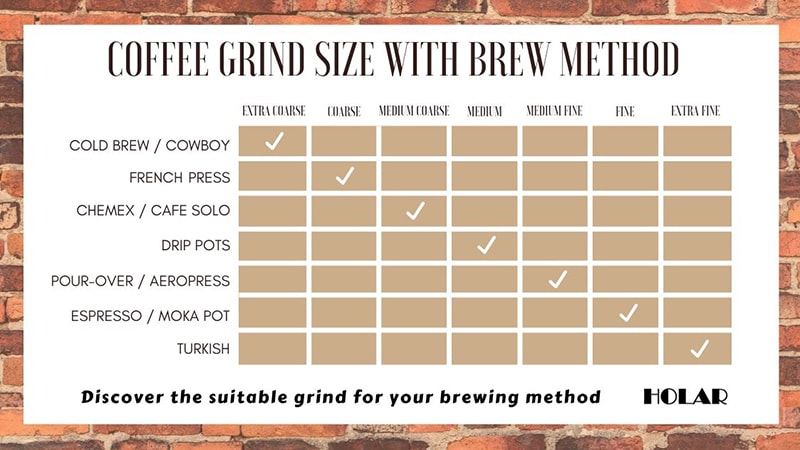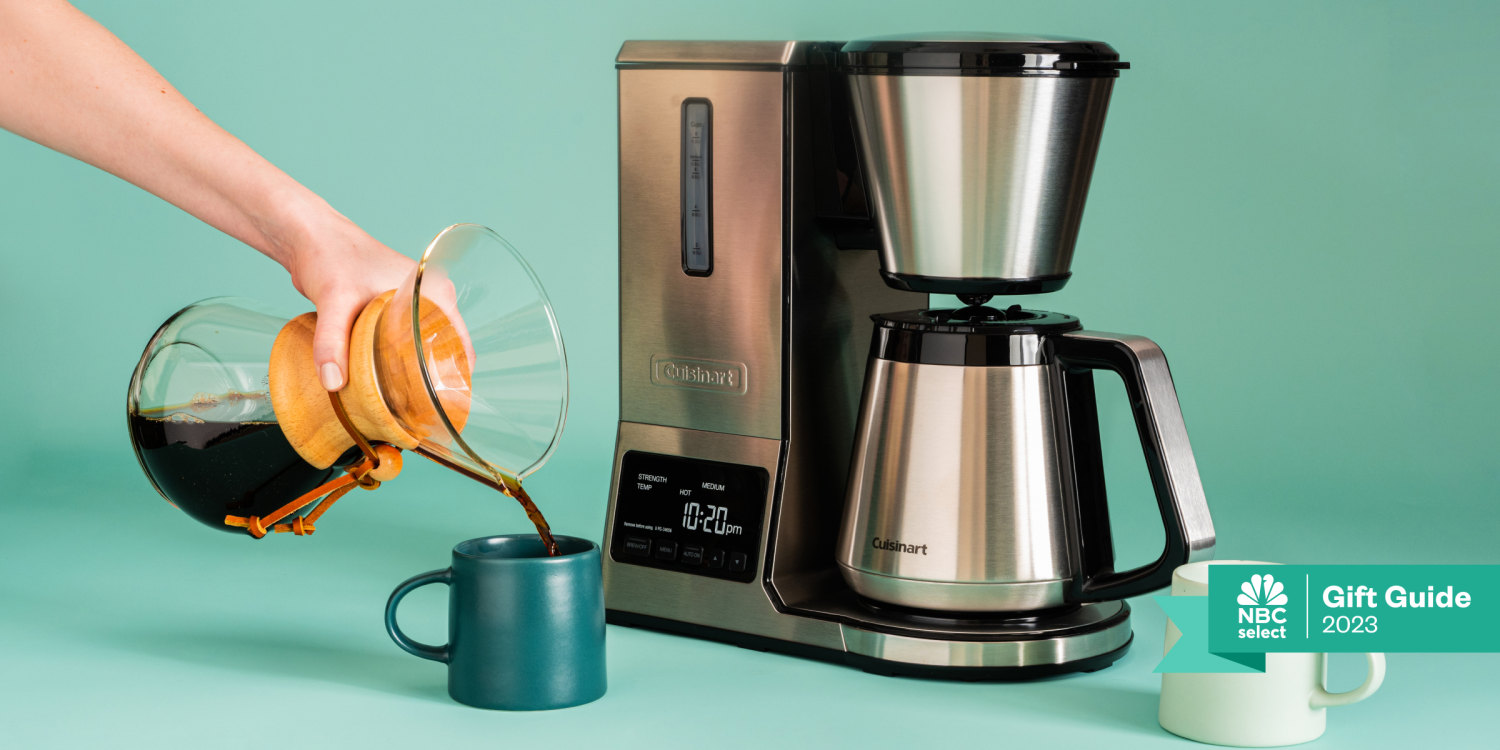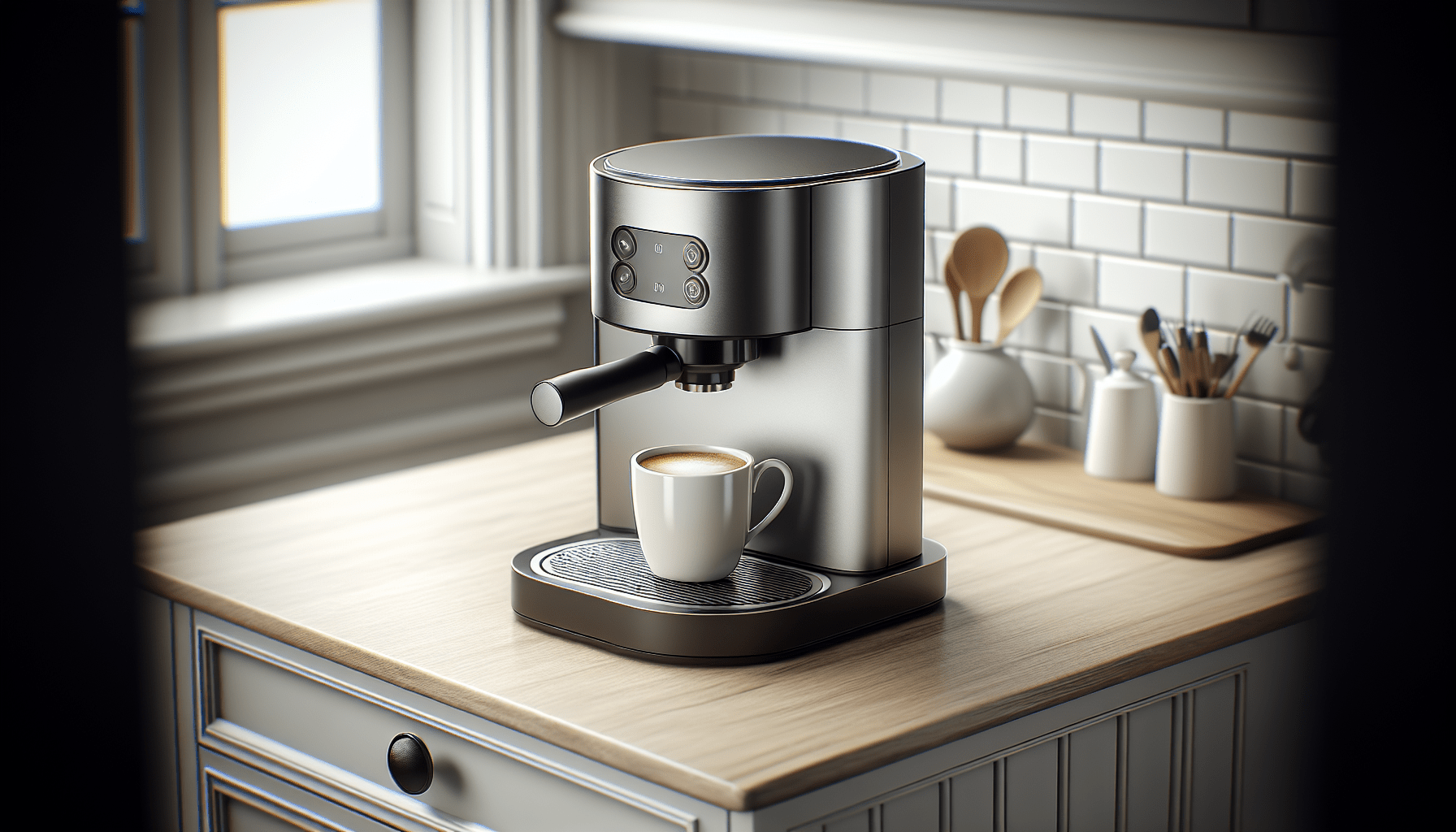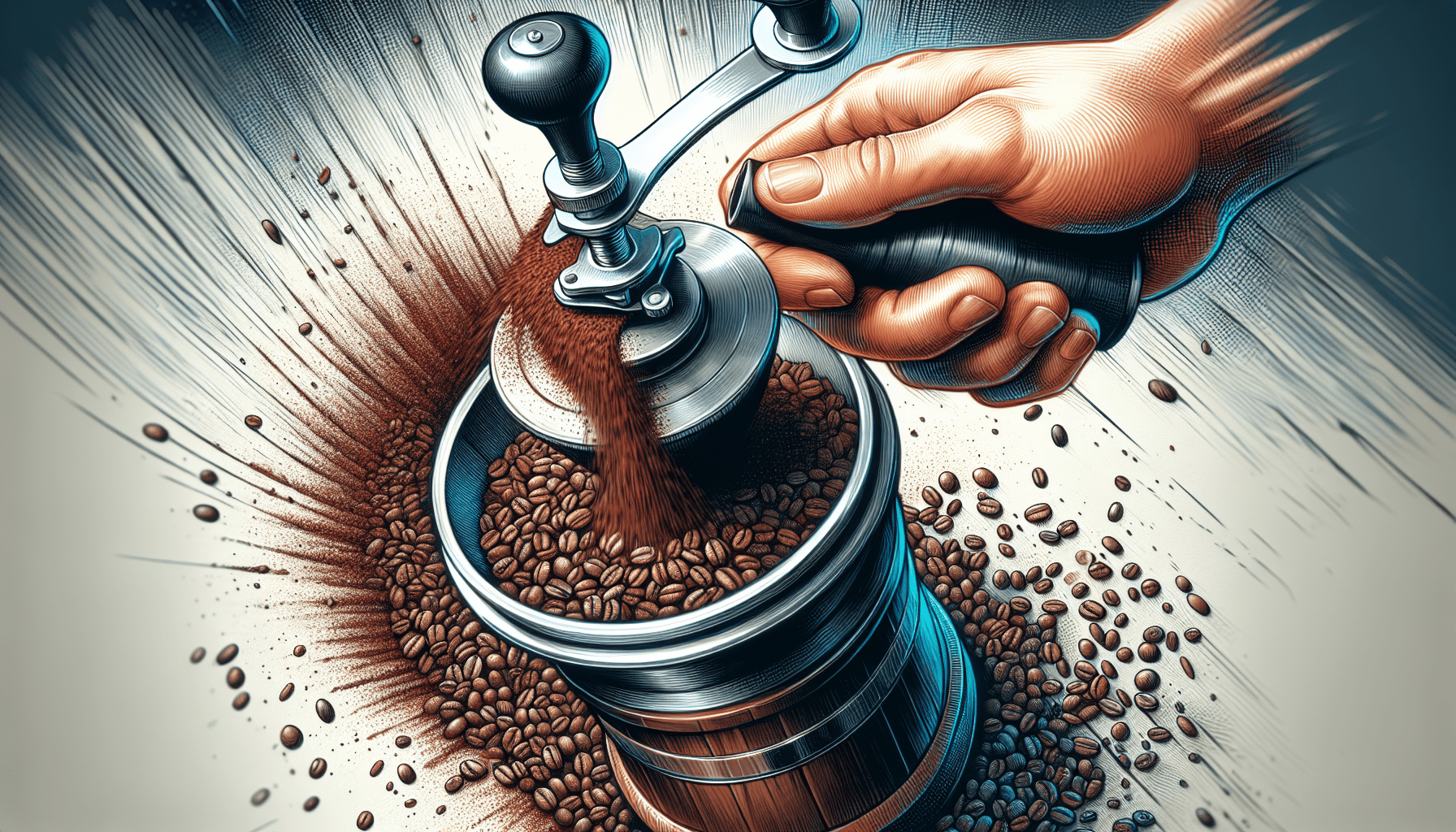Are you tired of ending up with either weak, flavorless coffee or bitter, over-extracted brews? Well, fret no more, because choosing the right grind size for your coffee maker is easier than you think. By understanding the different grind sizes and their impact on the brewing process, you can achieve the perfect cup of joe that suits your taste preferences. So, grab your favorite mug and let’s explore the world of grind sizes together!
Understanding the Importance of Grind Size
Grind size plays a crucial role in determining the quality of your coffee. It affects the extraction, flavor, and brewing time, making it essential to choose the right grind size for your coffee maker.
Impact on Extraction
The grind size directly impacts the extraction process. When water comes into contact with coffee grounds, it extracts soluble compounds, such as oils, sugars, and acids. Different extraction rates occur depending on the grind size.
A coarser grind size allows for less extraction, resulting in a milder and less intense flavor profile. On the other hand, a finer grind size leads to increased extraction, producing a stronger and more robust flavor.
Impact on Flavor
The size of your coffee grinds has a significant impact on the overall flavor of your brew. When water flows through the grounds, it dissolves different compounds, creating the unique taste characteristics of your coffee.
A coarser grind size tends to yield a more balanced and delicate flavor, allowing for a smoother and cleaner cup of coffee. In contrast, a finer grind size intensifies the flavors, bringing out the bold and vibrant notes in your brew.
Impact on Brewing Time
Grind size also affects the brewing time of your coffee. The surface area of the coffee grounds determines the rate at which water can pass through them.
Generally, a coarser grind size requires a longer brewing time to extract flavors adequately. Conversely, a finer grind size allows for a quicker extraction, reducing the brewing time.
Different Types of Coffee Grinds
Understanding the different types of coffee grinds is crucial in choosing the right one for your brewing method. Here are the six main types of coffee grinds:
Coarse Grind
Coarse grind coffee consists of larger particles, resembling sea salt or breadcrumbs. This grind size is perfect for brewing methods like the French press and cold brew, where a longer steeping time is desired to extract flavors.
Medium-Coarse Grind
Medium-coarse grind coffee has a texture similar to rough sand. It works well with pour-over methods, like the Chemex or V60, providing a balanced extraction and medium-bodied cup of coffee.
Medium Grind
Medium grind lies between medium-coarse and medium-fine, resembling granulated sugar. It suits pour-over methods like the Kalita Wave and drip coffee makers, producing a pleasant and well-rounded flavor profile.
Medium-Fine Grind
Medium-fine grind is slightly finer than granulated sugar, similar to table salt. It is commonly used for pour-over methods like the Aeropress and Siphon brewing, giving a more intense and nuanced flavor.
Fine Grind
Fine grind coffee resembles powdered sugar, with a texture finer than table salt. It is commonly used in espresso machines, allowing for a quick and thorough extraction to create the concentrated and full-bodied espresso shots.
Extra-Fine Grind
Extra-fine grind is the finest of all grinds, similar to flour or powdered sugar. This grind size is commonly used in Turkish coffee, where the coffee is brewed by boiling the fine grounds directly in water.
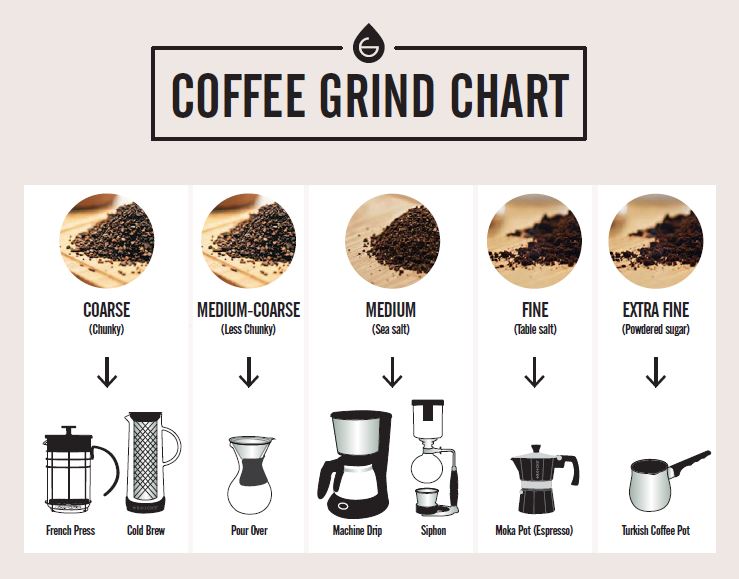
Choosing the Right Grind Size for Different Coffee Makers
To achieve the best results with your chosen brewing method, it is crucial to select the appropriate grind size. Here are the recommended grind sizes for various coffee makers:
French Press
For a French press, a coarse grind size is ideal. The large particles minimize sediment in the final brew while allowing for a longer extraction time and a full-bodied flavor.
Pour Over
Pour-over methods like the Chemex, V60, and Kalita Wave benefit from a medium-coarse to medium grind size. This range allows for a balanced extraction and ensures a clean and crisp cup of coffee.
Aeropress
The Aeropress works best with a medium to medium-fine grind size. The slightly finer grounds allow for a quicker extraction, resulting in a rich and aromatic cup of coffee.
Espresso Machine
For espresso machines, a fine grind size is necessary to achieve the desired extraction. The fine grounds create the necessary pressure to extract the intense flavors and oils inherent in espresso.
Moka Pot
When using a Moka pot, a medium-fine grind size works best. This allows for a steady extraction and balanced flavor, resulting in a strong and flavorful cup of coffee.
Cold Brew
Cold brew requires a coarse grind size. The larger particles allow for a longer steeping time, resulting in a smooth and low-acidity brew.
Factors to Consider in Grind Size Selection
When choosing the right grind size, several factors come into play. Consider the following before deciding on the grind size for your coffee:
Type of Coffee Beans
Different coffee beans have unique characteristics that can influence the grind size selection. For example, light roast beans require a finer grind to extract their delicate flavors fully, while dark roast beans may require a coarser grind to prevent over-extraction.
Roast Level
The roast level of your coffee beans also impacts the grind size selection. Lighter roasts usually require a finer grind to extract the subtle flavors, while darker roasts can handle a coarser grind size to prevent bitterness.
Brewing Method
The brewing method you choose should dictate the grind size. Each method has specific requirements to achieve optimal extraction. Consider the recommendations for your chosen brewing method to get the best results.
Personal Preference
Ultimately, your personal taste preference should guide your choice of grind size. Experiment with different grind sizes to find the one that produces the flavor profile you enjoy most.
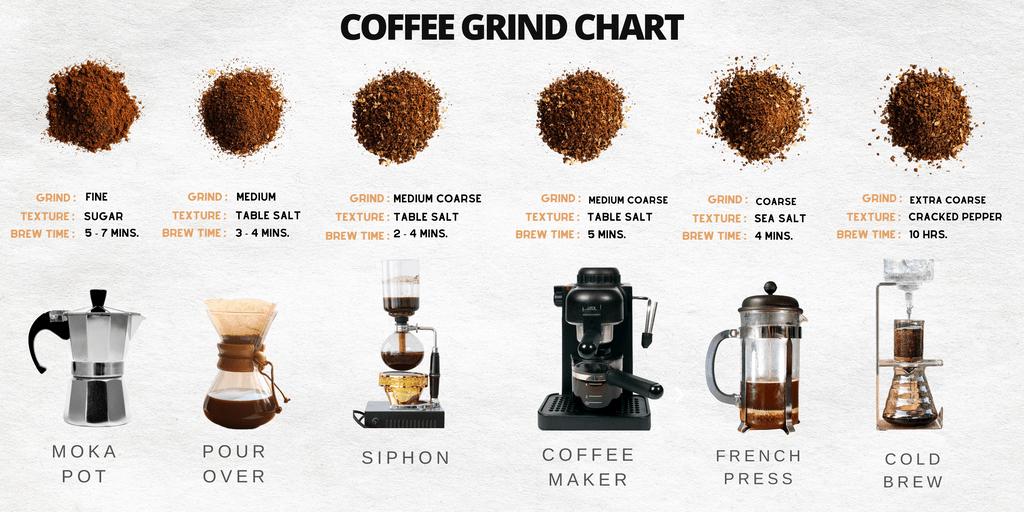
Determining the Grind Size
If you’re unsure about the appropriate grind size, there are a few methods you can use to determine the best option:
Visual Comparison
Comparing grind sizes side by side can provide a visual reference for choosing the right one. Use a sieve or colander to separate different grind sizes and compare them visually to determine the best fit for your brewing method.
Trial and Error
Don’t be afraid to experiment with different grind sizes. Start with the recommended range for your chosen brewing method and adjust accordingly. Tasting the resulting brew will help you determine the ideal grind size.
Grind Size Chart
Consulting a grind size chart specific to your brewing method can provide a helpful starting point. These charts offer general guidance on the appropriate grind size for each brewing method, allowing you to make an informed decision.
Tips for Achieving the Perfect Grind Size
Achieving the perfect grind size can greatly enhance the quality of your coffee. Consider the following tips to help you achieve the optimal grind size:
Invest in a Quality Grinder
Investing in a quality burr grinder ensures consistent and precise grinding. Blade grinders may produce uneven particle sizes, leading to inconsistent extraction and flavor.
Adjusting the Grind Size Gradually
When experimenting with grind size, it’s best to make gradual adjustments. Small changes can have a significant impact on extraction, so make subtle adjustments and taste the resulting brew before making further changes.
Experimenting with Ratios
In addition to adjusting the grind size, experimenting with coffee-to-water ratios can help fine-tune the flavor. Altering the ratio alongside the grind size allows for a comprehensive exploration of the brewing process.
Keep the Grinder Clean
Maintaining a clean grinder is vital for achieving consistent grind size. Coffee oils can build up over time, affecting the performance and flavor of the grinder. Regular cleaning prevents residue and ensures a quality grind.
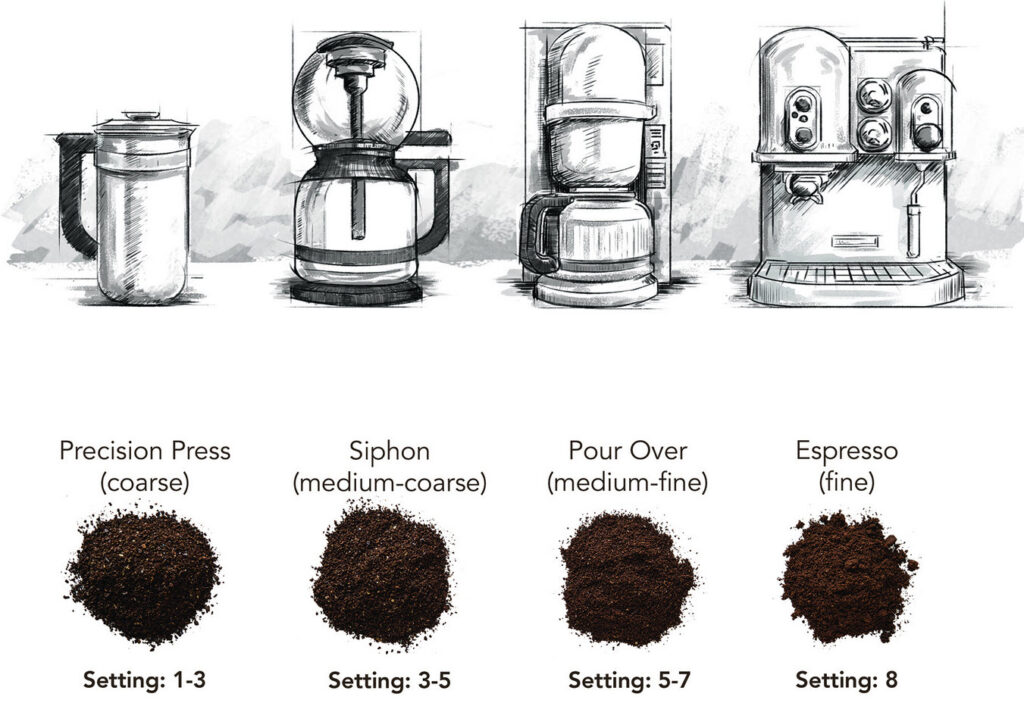
Common Mistakes to Avoid
To avoid common pitfalls in grind size selection, be mindful of the following mistakes:
Using Pre-Ground Coffee
Pre-ground coffee lacks the freshness and control that freshly ground coffee offers. Opt for grinding your beans just before brewing to ensure the best flavor and aroma.
Inconsistent Grind Size
Inconsistency in grind size can lead to uneven extraction and flavor imbalances. Ensure that each coffee particle is of a similar size to achieve consistent extraction and a well-balanced brew.
Ignoring Manufacturer’s Recommendations
Ignoring the manufacturer’s recommendations for grind size can lead to subpar results. Manufacturers often provide specific instructions for achieving the best extraction with their brewing method, so it’s best to follow their guidance.
Troubleshooting Grind Size Issues
If you encounter issues with your grind size selection, here are some common problems and their solutions:
Over-Extracted or Bitter Coffee
If your coffee tastes overly bitter and harsh, it may be over-extracted. Try using a coarser grind size and adjusting the brewing time to prevent excessive extraction.
Under-Extracted or Weak Coffee
Weak and lackluster coffee may indicate under-extraction. In this case, try using a finer grind size and extending the brewing time slightly to extract more flavors.
Uneven Extraction
Uneven extraction often occurs when the grind size is inconsistent. Ensure that your grinder is producing a uniform grind to achieve even extraction throughout the coffee bed.

Importance of Freshly Ground Coffee
Using freshly ground coffee is crucial for a superior brewing experience. Here are a few reasons why freshly ground coffee is essential:
Flavor and Aroma
Freshly ground coffee retains its natural flavors and aromas to a greater extent. The moment coffee beans are ground, the volatile compounds begin to oxidize, resulting in a loss of flavor and aroma over time.
Oxidation
Oxidation occurs when ground coffee comes into contact with air, causing the release of volatile compounds and degradation of flavor. By grinding coffee just before brewing, you minimize exposure to air, preserving the freshness.
Preserving Coffee Quality
Whole coffee beans have a protective layer that helps retain their quality. Grinding the beans exposes a greater surface area to oxygen, accelerating oxidation and diminishing the overall quality of the coffee.
Conclusion
In conclusion, understanding the importance of grind size is crucial for achieving the perfect cup of coffee. The impact on extraction, flavor, and brewing time cannot be underestimated. By considering factors such as coffee beans, roast level, brewing method, and personal preference, you can choose the appropriate grind size for your coffee maker. Utilizing visual comparisons, trial and error, and grind size charts can help in determining the ideal grind size. Remember to invest in a quality grinder, adjust the grind size gradually, and maintain cleanliness to achieve consistent results. Avoid common mistakes, troubleshoot any issues, and prioritize using freshly ground coffee to enjoy the best possible coffee experience.
